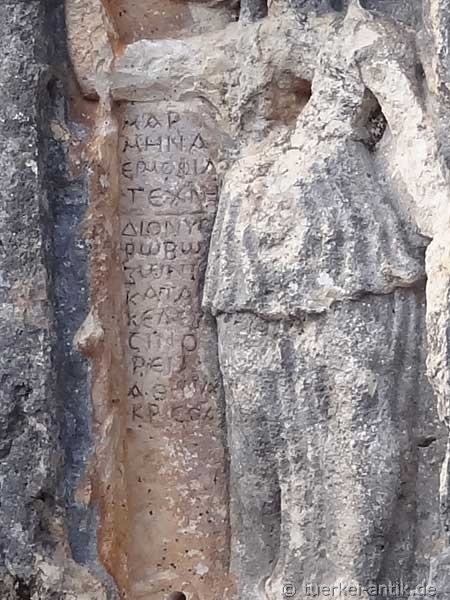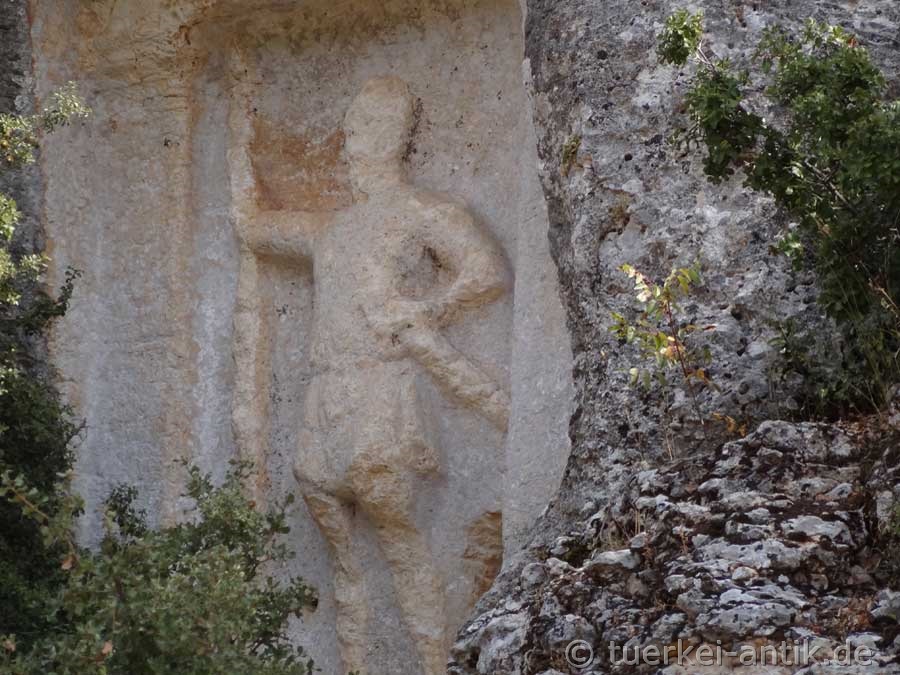 |
| Sömek in Cilicia | |||
|
|
|
||
| The Athena relief | |||
|
The village of Sömek is located about 15 kilometres from the Mediterranean coast in the mountainous hinterland of Kızkalesi. Probably in the 2nd century a relief was carved into a rock in the north of the village in honour of the goddess Athena. |
|||
|
|
|||
| The relief is easy to overlook | |||
|
The relief is carved into the rock at a height of about 1.50 metres above the ground. It has a total height of 1.30 metres. In a niche, which is closed by a shell at the top, there is the image of a woman who was identified as the goddess Athena, among other things by the inscription. |
|||
|
|
|||
|
The inscription next to the figure |
|||
|
Between the lance held on the left and the female figure the inscription is engraved in a narrow field in 13 lines. In it the goddess is called Αθηνα Κρισοα (Athena Krisoa), whereby the epithet Κρισοα derived from a place name refers to a local variant of the deity; the associated place Κρισοα could not be localized yet. However, it must have certainly been in the north of the rough Cilicia. |
|||
|
|
|||
| The warrior relief of Efrenk | |||
|
|
|||
| The warrior relief of Efrenk | |||
|
|
|||
|
About 600 meters northwest of the Athena relief lies the warrior relief of Efrenk in a rock face next to a steep path leading to the Lamos River. The relief is worked about five meters above the street level into the vertical rock face. It is 1.90 metres high. It shows a standing warrior frontally framed by a Naiscos. |
|||
|
|
|||
|
|
|||
|
|
|||
|
The legs are badly damaged. The raised right arm rests on a vertical lance, on the left side he carries a sword, whose handle he holds with the angled left arm. He is dressed in a short chiton with a belt whose bulging folds are clearly visible. |
|||
|
|
|||
|
|
|||
|
|
|||
|
On the left pilaster, an eight-line inscription is carved approximately at the height of the belt. The two ancient historians Josef Keil and Adolf Wilhelm, who visited Cilicia in 1891 and 1925, published a report in 1931 in which they reported illegible remains of an actual tomb inscription located to the left and right of the head of the figure at the relief base. |
|||
| Photos: @chim | |||
| Translation aid: www.DeepL.com/Translator | |||
| Source: Wikipedia and others | |||
|
|
|||



